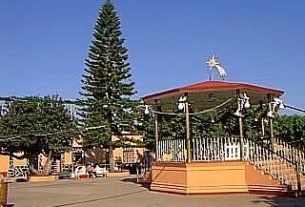LOCATION: The State of Tabasco is located in southeastern Mexico. It is bordered to the north by the Gulf of Mexico, to the northwest by Campeche, to the southeast by Guatemala, to the south by the state of Chiapas, and to the west by Veracruz.
GENERAL INFORMATION: The territory consists mostly of wet lowlands covered by vegetation with some swamps. Its climate is generally warm and humid, with heavy rains throughout the year. The annual average temperature in the capital city of Villahermosa is 25.2 degrees Celsius. The Usumacinta, Grijalba, Tonala and Mexcalapa-Rio Grande Rivers, which constitute Mexico´s most important watershed, have endowed Tabasco with great riparian resources. Tabasco´s land surface is 25,267 square kilometers, which ranks 24th among the 32 states of Mexico.
POPULATION: The total population of Tabasco according to the 1990 Census is 1,501,183 people. The largest city is the capital, Villahermosa, whose municipal area has over 390,000 inhabitants. The municipalities of Cardenas, Comalcalco, Humanguillo, and Macuspana each are home to more than 100,000 people.
COMMUNICATIONS: The State has 7,488 kms. of roads and 2,953 kms. of paved highways which connect Tabasco with the main cities of Mexico. It has one international airport located in Villahermosa and 26 airfields distributed across the state. It also has 302 kms. of railroads which link Tabasco with the national railroad system.
SUPERIOR EDUCATION: Tabasco has 21 colleges and universities, featuring the Universidad Autonoma de Villahermosa and the Instituto Arquelogico de Villahermosa, plus 12 technical schools located throughout the state.
ECONOMY: Tabasco has a labor force of around 500,000, according to the 1990 Census. Commerce and services employ 43% of Tabascan workers, while a third are employed in the primary sector, which includes agriculture. Mining and industry provide jobs for 20.8% of the work force.
Tabasco´s Gross State Product of 6.29 billion US dollars accounts for 3.05% of Mexico´s total GNP. Mining is the largest component of Tabasco´s Gross State Product, at 54.3% of the total. Tabasco is especially rich in oil and gas, as much of Mexico´s petroleum reserves are located in the state. Over a quarter of national crude oil production and almost half of natural gas production comes from Tabasco.
Trade and other services are also a major part of Tabasco´s emerging economy. Eleven percent of Tabasco´s economic production comes from trade, while fifteen percent derives from commercial and other services.
The state also has a vibrant agricultural sector, accounting for hundreds of millions of dollars in state economic output. Farming is carried out over a surface area of 220,000 hectares. Tabasco ranks first in the country in cocoa production. Other major agricultural products include rice, sugar cane, coconuts, rubber, oranges, and bananas. Cattle and poultry are raised on an additional one million hectares.
With 250 kms. of coastline, fishing is an important part of Tabasco´s economy. Sixty different species of seafood are harvested in the waters off the state, and Tabasco provides 38.7% of Mexico´s annual oyster catch.
Manufacturing and industrial production accounts for seven percent of the Gross State Product. Petrochemicals and oil by-products are the primary industries in the state. Tabasco also produces and exports processed meat, sugar, cooking oil, cocoa, and cocoa by-products.
Other industries in the state include wood and cork processing plants, yucca dehydration plants, canned oysters, door and window manufacturing, cement production, and leather products.
Today, Tabasco has three modern industrial parks in the city of Villahermosa which offer excellent services for setting up a plant, such as water, draining, gas, electricity, and telephone services.
TOURISM: The state offers many tourist attractions including archaeological sites, beaches, arts & crafts, museums, and cultural centers. Among the main tourist centers in Tabasco are Tenosique, Comalcalco, Jonuta, Laguna del Carmen, Teapa, Nacajuca, Playa Azul, and Laguna de las Flores. The city of Villahermosa offers wonderful attractions such as the “La Venta” museum with natural forests and archaeological pieces from the Olmec civilization.
HISTORY AND CULTURE: The name of the state of Tabasco comes from “Taabs Coob,” who was chief of the Potonchan region, located along the Grijalba River, at the arrival of the Spaniards in Mexico. It was founded by Hernan Cortes with the name “Santa Maria de la Victoria or Villa de Tabasco” in 1519 on the left bank of the Grijalba.
The site known as “La Venta¨ in present-day Tabasco was the birthplace of the enigmatic and glorious Olmec civilization. La Venta is the oldest site in Mexico, dating back to the second millennium BC to the first century AD (1500 BC – 100 AD). The Olmecs, whose name means “inhabitant of the rubber region,” were the predecessors of the Mayans, whose civilization reached its pinnacle between 600 and 200 B. C.
The site of La Venta is formed by a group of altars and tombs carved from basalt. Human figures with an intriguing mix of negroid and mongoloid features are carved on the columns. The style of the stonework of La Venta reflects the excellence, the universality, and the permanence of classic art.
Also part of the Olmec archaeological legacy are the trails, figurines, and colossal heads carved in stone which were discovered from 1939 to 1941 by Dr. Matthew Stirling at ¨Tres Zapotes¨ and the wrought jades located at the “Cerro de Las Mesas.”
The Mayan culture can also be admired at many places in the state of Tabasco, such as Comalcalco, Pomona and “El Tortuguero.” (The ruins of Palenque in the state of Chiapas are located only a short distance from Villahermosa.)
Tabasco offers countless, in many cases unexplored, archaeological sites of different cultures and periods, which are surrounded by an exuberant jungle environment which brings out their beauty and their mysteries. The state has many museums and cultural centers distributed in cites with great tourist facilities.
The following article is reproduced with the kind permission of the Consul General in Austin Texas.
It first appeared in their Gaceta Consular, December 1996 – Austin, Texas – Year IV, Number 25

